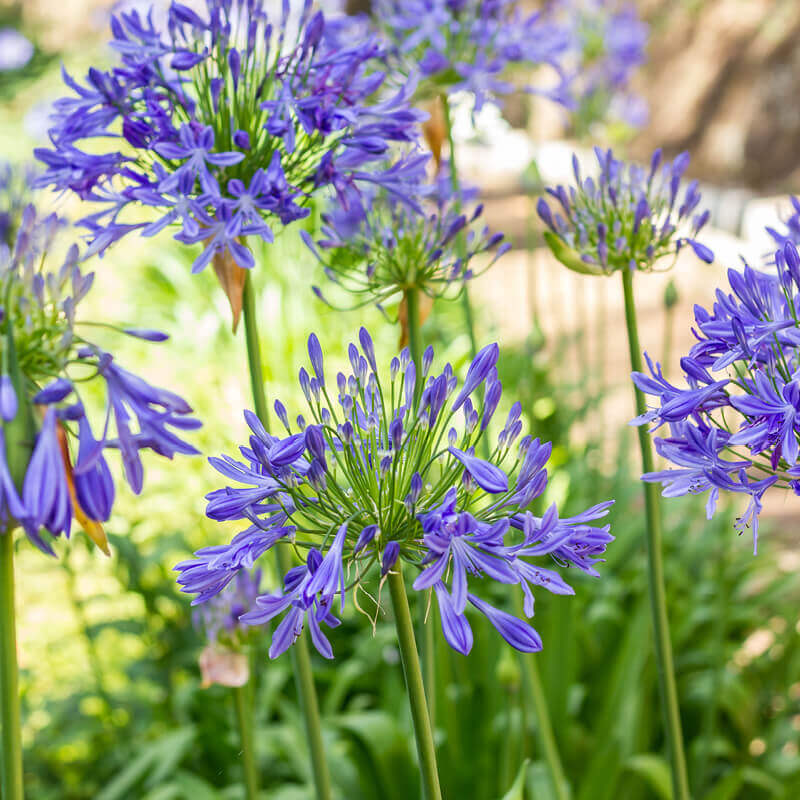Agapanthus Expanding Problems: Dirt, Sunlight, and Watering
Agapanthus Expanding Problems: Dirt, Sunlight, and Watering
Blog Article
Understanding the Art of Agapanthus Treatment: Vital Actions for Healthy And Balanced Growth and Vibrant Blooms
In the world of gardening, the growing of agapanthus stands as a gratifying undertaking for those that seek to nurture these classy blooming plants. From choosing the ideal range to understanding trimming methods, the trip in the direction of growing prospering agapanthus plants is multifaceted and holds the key to opening the full possibility of these organic gems.

Picking the Right Agapanthus Range

When picking the appropriate Agapanthus range for your garden, think about elements such as climate suitability, flower color, and growth routine. In addition, think about the climate in your area to ensure the Agapanthus selection you choose can flourish in your specific problems. Comprehending the development behavior of various Agapanthus varieties is important for proper positioning within your yard.
Perfect Planting Conditions
Considering the optimal ecological requirements is essential for effective Agapanthus growing. Agapanthus plants are delicate to chilly temperatures and ought to be secured from frost during wintertime months.
To make sure healthy and balanced growth and vibrant blossoms, plant Agapanthus light bulbs at a depth of regarding 2-4 inches and room them 8-12 inches apart. Including raw material, such as garden compost, to the dirt can improve drain and fertility, advertising durable origin growth. Mulching around the base of the plants assists preserve wetness and suppresses weed development. Routine watering is important, specifically during the expanding season, to maintain the dirt consistently damp yet not saturated.
Watering and Feeding Tips
Preserving appropriate dampness degrees and providing essential nutrients are vital elements in the treatment program for Agapanthus plants. When it comes to watering Agapanthus, it is vital to strike an equilibrium. These plants favor continually moist soil but are susceptible to root rot if overwatered.
Fertilizing Agapanthus is crucial for advertising healthy growth and prolific blossoms. Apply a well balanced plant food, such as a 10-10-10 formula, in the early spring as brand-new development emerges. By following these watering and feeding suggestions, you can guarantee your Agapanthus plants flourish and create lively, resilient flowers.
Trimming Techniques for Agapanthus
Trimming Agapanthus plants at the ideal times and with correct techniques is essential for preserving their wellness and promoting ideal development and flowering. The perfect time to prune Agapanthus is in late winter or early springtime before brand-new development arises. Begin by getting rid of any kind of yellowing or dead leaves near the base of the plant. Cut them as short as feasible without damaging the arising shoots.
Deadheading spent blossoms can additionally reroute the plant's power right into creating more blooms rather than establishing seeds. If you desire to gather seeds for breeding, leave some my latest blog post blossoms to completely dry and fully grown on the plant.
Remember to utilize tidy, sharp tools to make precise cuts and reduce the danger of introducing diseases. Agapanthus. Normal trimming will help maintain your Agapanthus looking neat and healthy and balanced while making sure a plentiful display of attractive blossoms
Handling Common Parasites and Illness
After making certain correct trimming techniques for Agapanthus, it is necessary to address typical insects and diseases that can influence the wellness check these guys out and vigor of these plants. One common pest that affects Agapanthus is the Agapanthus gall midget.
Another common concern is fungal fallen leave spot, which provides as dark sores on the fallen leaves. To stop fungal diseases, make sure excellent air circulation around the plants, stay clear of above watering, and get rid of any type of infected leaves immediately. Additionally, Agapanthus plants can suffer from origin rot if they are planted in poorly draining pipes soil. To prevent this, plant Agapanthus in well-draining soil and stay clear of overwatering. By being watchful and taking prompt activity versus insects and conditions, you can help your Agapanthus plants prosper and produce vibrant flowers.

Verdict
Finally, grasping the art of agapanthus care entails choosing the right selection, supplying optimal Find Out More planting problems, correct watering and feeding, proper pruning methods, and attending to usual pests and diseases. By complying with these crucial actions, you can make sure healthy and balanced growth and dynamic blooms for your agapanthus plants. Remember to frequently monitor and keep your plants to promote their total wellness and durability.
To make sure healthy and balanced development and vibrant flowers, plant Agapanthus bulbs at a depth of concerning 2-4 inches and space them 8-12 inches apart. By complying with these watering and feeding pointers, you can ensure your Agapanthus plants thrive and generate lively, durable blooms.
One typical pest that impacts Agapanthus is the Agapanthus gall midget. Additionally, Agapanthus plants can endure from origin rot if they are planted in improperly draining soil. By complying with these vital actions, you can ensure healthy development and vivid blooms for your agapanthus plants.
Report this page